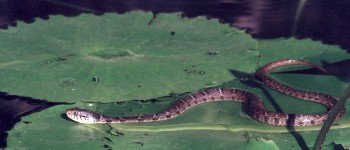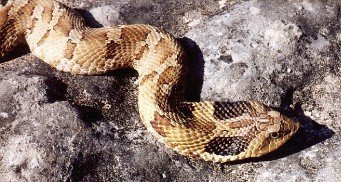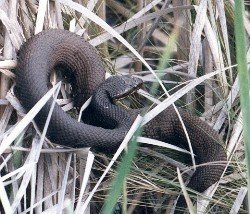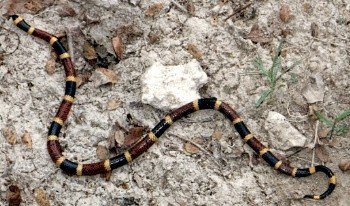 A couple of years ago, I had the thrill of seeing the first snake to visit our gardens. It was a young eastern blackneck garter snake (Thamnophis cyrtopsis ocellatus), one of the most beautiful of the garter snakes and a favorite of hobbyists. The photo above shows a mature example of this species. Since that time, I've occasionally found other baby garter snakes in our yard, but they hide very well so these sightings are rare. Garter snakes prey mainly on toads, frogs, and small fish, so any individuals in our yard would be well fed because of our ponds.
A couple of years ago, I had the thrill of seeing the first snake to visit our gardens. It was a young eastern blackneck garter snake (Thamnophis cyrtopsis ocellatus), one of the most beautiful of the garter snakes and a favorite of hobbyists. The photo above shows a mature example of this species. Since that time, I've occasionally found other baby garter snakes in our yard, but they hide very well so these sightings are rare. Garter snakes prey mainly on toads, frogs, and small fish, so any individuals in our yard would be well fed because of our ponds.

While we don't have adequate habitat for very many snakes within the confines of our own yard, I have often found them in other gardens and parks around Austin. The pretty little redstripe ribbon snake (Thamnophis proximus rubrilineatus) shown above was photographed at Zilker Gardens, which is a also a particularly good place to see both garter and water snakes. Garter snakes are just as likely to be seen in the the low bushes and other vegetation as crawling around on the rocks. They are probably just trying to get drier and warmer, and they seem to climb quite well. Since I often visit the Gardens in the early morning, I frequently see the snakes looking for a warm basking place before they are scared off by too many people walking around.


While the garter snake is often seen in gardens, around the lakes and ponds here in Austin one is more likely to encounter the blotched water snake (Nerodia erythrogaster transversa) and diamondback water snake (Nerodia rhombifera rhombifera). These snakes have beautiful brown markings and can often be seen in the ponds at Zilker Gardens or anywhere around Town Lake. They are frequently mistaken for water moccasins or cottonmouths, not only because of similar appearance, but also because they are aggressive if caught or molested. The blotched water snake on the lily pads pictured at left was photographed in one of the ponds at Zilker. When I was kayaking, I happened to see the diamondback water snake at right in the process of swallowing a large (for the snake) fish. Snakes' jaws are very loosely connected and can expand to an incredible size to allow for large prey. The teeth all point inwards so the snake can grip anything from slimy frogs to slippery fish.
 One of the more entertaining snakes in our area is the eastern hognose snake (Heterodon platyrhinos). The accompanying photo, taken at McKinney Falls State Park, shows a young hognose snake in one of its defensive postures: flattened out to appear larger and more dangerous. In reality, hognose snakes are one of the few bigger snakes that never bite people. This is because its largest teeth are in the rear of its mouth, which is efficient for small amphibious prey, but almost useless against predatory animals. While hognose snakes are adept at burrowing, if they are caught out in the open, they have almost no real defenses. They do, however, have quite a repertoire of strange behaviors that have evolved to help the snakes make themselves seem unattractive as meals. Besides the flattening, which is accomplished by the snake spreading its ribs out, a hognose snake sometimes coils, makes fake strikes, hisses loudly, hides its head under its coiled tail, discharges musk, vomits, or plays dead. This final trick looks very convincing, with the tongue hanging out loosely and the snake lying on its back. It will even remain limp if picked up. One flaw in the act, though, is that the snake will sometimes flip itself back over if it is put upright.
One of the more entertaining snakes in our area is the eastern hognose snake (Heterodon platyrhinos). The accompanying photo, taken at McKinney Falls State Park, shows a young hognose snake in one of its defensive postures: flattened out to appear larger and more dangerous. In reality, hognose snakes are one of the few bigger snakes that never bite people. This is because its largest teeth are in the rear of its mouth, which is efficient for small amphibious prey, but almost useless against predatory animals. While hognose snakes are adept at burrowing, if they are caught out in the open, they have almost no real defenses. They do, however, have quite a repertoire of strange behaviors that have evolved to help the snakes make themselves seem unattractive as meals. Besides the flattening, which is accomplished by the snake spreading its ribs out, a hognose snake sometimes coils, makes fake strikes, hisses loudly, hides its head under its coiled tail, discharges musk, vomits, or plays dead. This final trick looks very convincing, with the tongue hanging out loosely and the snake lying on its back. It will even remain limp if picked up. One flaw in the act, though, is that the snake will sometimes flip itself back over if it is put upright.
 A common misconception about snakes is that most of them are venomous. There are several venomous snakes in our area, but there are far more nonvenomous species. All are beneficial in that they keep rodent populations in check. I have seen water moccasins, or western cottonmouths (Agkistrodon piscivorus leucostoma), in some areas of Texas, but have not seen any on Town Lake in Austin even though I have been kayaking there quite a bit for about 20 years, as well as swimming in the upper parts of the lake. If they are living there, they are much more secretive than the common water snakes, which can be seen basking on tree roots and rocks all along the shore at times. Just outside of Austin, I have encountered water moccasins, particularly on the small creeks around the Pedernales River. The photo shown at left was taken at Sea Rim State Park, along the Texas Gulf Coast, where water moccasins may be easily viewed. A common misconception about snakes is that most of them are venomous. There are several venomous snakes in our area, but there are far more nonvenomous species. All are beneficial in that they keep rodent populations in check. I have seen water moccasins, or western cottonmouths (Agkistrodon piscivorus leucostoma), in some areas of Texas, but have not seen any on Town Lake in Austin even though I have been kayaking there quite a bit for about 20 years, as well as swimming in the upper parts of the lake. If they are living there, they are much more secretive than the common water snakes, which can be seen basking on tree roots and rocks all along the shore at times. Just outside of Austin, I have encountered water moccasins, particularly on the small creeks around the Pedernales River. The photo shown at left was taken at Sea Rim State Park, along the Texas Gulf Coast, where water moccasins may be easily viewed.
 One snake that is very venomous (it is related to cobras), but not dangerous considering that it has a small mouth and is very nonaggressive, is the Texas coral snake (Micrurus fulvius tenere). The red segments of this subspecies have so many black specks mixed in that it appears maroon instead of bright red. It is still a beautiful snake, being very smooth and glossy, and I was fortunate to find one out in the open while hiking in dried-up Barton Creek. They usually stay hidden and in fact are a burrowing snake that feeds on lizards and other snakes. The scarlet king snake can sometimes be mistaken for a coral snake, but the shape of their heads is quite different and the order of red, black and yellow bands is also distinct (although I can never remember what it is specifically). The best way to avoid being bitten by a coral snake is to not handle them. One snake that is very venomous (it is related to cobras), but not dangerous considering that it has a small mouth and is very nonaggressive, is the Texas coral snake (Micrurus fulvius tenere). The red segments of this subspecies have so many black specks mixed in that it appears maroon instead of bright red. It is still a beautiful snake, being very smooth and glossy, and I was fortunate to find one out in the open while hiking in dried-up Barton Creek. They usually stay hidden and in fact are a burrowing snake that feeds on lizards and other snakes. The scarlet king snake can sometimes be mistaken for a coral snake, but the shape of their heads is quite different and the order of red, black and yellow bands is also distinct (although I can never remember what it is specifically). The best way to avoid being bitten by a coral snake is to not handle them.
Perhaps our strangest snake is the plains blind snake (Leptotyphlops dulcis dulcis). It is frequently found in garden compost bins and also shows up inside houses after heavy rains. Also called a worm snake, it looks quite a bit like a very lively, large earthworm. Blind snakes are smooth, have an iridescent sheen, and the eyes are nearly invisible. They look pretty much the same at both ends, but the scales point towards the tail.  My first encounter with one occurred when it happened to appear in the middle of our kitchen floor one night, following torrential rains. As it could not gain enough traction to move anywhere on the slippery tile, I'm not sure how it got where it did in the first place. It writhed constantly and felt very muscular as I picked it up. It also did what a lot of snakes do as a defensive strategy: it excreted a noxious smelling liquid. If I had any doubt that what I was holding was actually a snake, that was enough to dispel all uncertainty. These tiny snakes, which are usually about six inches long, often live under the concrete slabs of houses and will escape rising water through the openings for pipes and drains. Blind snakes cannot bite because they have a very small mouth, and are extremely beneficial, eating mostly termites and ants. The close-up photo of a blind snake was taken of one found dead in our lawn. The eyes are barely discernible and covered with scales. There is a sturdy shield over the front of the nose. While not spectacular, these interesting little reptiles are quite a curiosity. My first encounter with one occurred when it happened to appear in the middle of our kitchen floor one night, following torrential rains. As it could not gain enough traction to move anywhere on the slippery tile, I'm not sure how it got where it did in the first place. It writhed constantly and felt very muscular as I picked it up. It also did what a lot of snakes do as a defensive strategy: it excreted a noxious smelling liquid. If I had any doubt that what I was holding was actually a snake, that was enough to dispel all uncertainty. These tiny snakes, which are usually about six inches long, often live under the concrete slabs of houses and will escape rising water through the openings for pipes and drains. Blind snakes cannot bite because they have a very small mouth, and are extremely beneficial, eating mostly termites and ants. The close-up photo of a blind snake was taken of one found dead in our lawn. The eyes are barely discernible and covered with scales. There is a sturdy shield over the front of the nose. While not spectacular, these interesting little reptiles are quite a curiosity.
I have had many more interesting encounters with snakes than I have been able to photograph, including watching a hognose snake eat a toad (which took about 20 minutes), observing a beautiful rough green snake slither along a dusty gravel road, and having a very large, dark snake (I'm not sure of the species) fall on my shoulder when I was climbing a heavily forested hillside. In this last encounter, the snake was so heavy that I thought somebody had sneaked up behind me as I hiked alone and had put their arm on me, so I was much relieved to find out it was only a snake.
|




 One of the more entertaining snakes in our area is the eastern hognose snake (Heterodon platyrhinos). The accompanying photo, taken at McKinney Falls State Park, shows a young hognose snake in one of its defensive postures: flattened out to appear larger and more dangerous. In reality, hognose snakes are one of the few bigger snakes that never bite people. This is because its largest teeth are in the rear of its mouth, which is efficient for small amphibious prey, but almost useless against predatory animals. While hognose snakes are adept at burrowing, if they are caught out in the open, they have almost no real defenses. They do, however, have quite a repertoire of strange behaviors that have evolved to help the snakes make themselves seem unattractive as meals. Besides the flattening, which is accomplished by the snake spreading its ribs out, a hognose snake sometimes coils, makes fake strikes, hisses loudly, hides its head under its coiled tail, discharges musk, vomits, or plays dead. This final trick looks very convincing, with the tongue hanging out loosely and the snake lying on its back. It will even remain limp if picked up. One flaw in the act, though, is that the snake will sometimes flip itself back over if it is put upright.
One of the more entertaining snakes in our area is the eastern hognose snake (Heterodon platyrhinos). The accompanying photo, taken at McKinney Falls State Park, shows a young hognose snake in one of its defensive postures: flattened out to appear larger and more dangerous. In reality, hognose snakes are one of the few bigger snakes that never bite people. This is because its largest teeth are in the rear of its mouth, which is efficient for small amphibious prey, but almost useless against predatory animals. While hognose snakes are adept at burrowing, if they are caught out in the open, they have almost no real defenses. They do, however, have quite a repertoire of strange behaviors that have evolved to help the snakes make themselves seem unattractive as meals. Besides the flattening, which is accomplished by the snake spreading its ribs out, a hognose snake sometimes coils, makes fake strikes, hisses loudly, hides its head under its coiled tail, discharges musk, vomits, or plays dead. This final trick looks very convincing, with the tongue hanging out loosely and the snake lying on its back. It will even remain limp if picked up. One flaw in the act, though, is that the snake will sometimes flip itself back over if it is put upright.
 A common misconception about snakes is that most of them are venomous. There are several venomous snakes in our area, but there are far more nonvenomous species. All are beneficial in that they keep rodent populations in check. I have seen water moccasins, or western cottonmouths (Agkistrodon piscivorus leucostoma), in some areas of Texas, but have not seen any on Town Lake in Austin even though I have been kayaking there quite a bit for about 20 years, as well as swimming in the upper parts of the lake. If they are living there, they are much more secretive than the common water snakes, which can be seen basking on tree roots and rocks all along the shore at times. Just outside of Austin, I have encountered water moccasins, particularly on the small creeks around the Pedernales River. The photo shown at left was taken at Sea Rim State Park, along the Texas Gulf Coast, where water moccasins may be easily viewed.
A common misconception about snakes is that most of them are venomous. There are several venomous snakes in our area, but there are far more nonvenomous species. All are beneficial in that they keep rodent populations in check. I have seen water moccasins, or western cottonmouths (Agkistrodon piscivorus leucostoma), in some areas of Texas, but have not seen any on Town Lake in Austin even though I have been kayaking there quite a bit for about 20 years, as well as swimming in the upper parts of the lake. If they are living there, they are much more secretive than the common water snakes, which can be seen basking on tree roots and rocks all along the shore at times. Just outside of Austin, I have encountered water moccasins, particularly on the small creeks around the Pedernales River. The photo shown at left was taken at Sea Rim State Park, along the Texas Gulf Coast, where water moccasins may be easily viewed.
 One snake that is very venomous (it is related to cobras), but not dangerous considering that it has a small mouth and is very nonaggressive, is the Texas coral snake (Micrurus fulvius tenere). The red segments of this subspecies have so many black specks mixed in that it appears maroon instead of bright red. It is still a beautiful snake, being very smooth and glossy, and I was fortunate to find one out in the open while hiking in dried-up Barton Creek. They usually stay hidden and in fact are a burrowing snake that feeds on lizards and other snakes. The scarlet king snake can sometimes be mistaken for a coral snake, but the shape of their heads is quite different and the order of red, black and yellow bands is also distinct (although I can never remember what it is specifically). The best way to avoid being bitten by a coral snake is to not handle them.
One snake that is very venomous (it is related to cobras), but not dangerous considering that it has a small mouth and is very nonaggressive, is the Texas coral snake (Micrurus fulvius tenere). The red segments of this subspecies have so many black specks mixed in that it appears maroon instead of bright red. It is still a beautiful snake, being very smooth and glossy, and I was fortunate to find one out in the open while hiking in dried-up Barton Creek. They usually stay hidden and in fact are a burrowing snake that feeds on lizards and other snakes. The scarlet king snake can sometimes be mistaken for a coral snake, but the shape of their heads is quite different and the order of red, black and yellow bands is also distinct (although I can never remember what it is specifically). The best way to avoid being bitten by a coral snake is to not handle them.
 My first encounter with one occurred when it happened to appear in the middle of our kitchen floor one night, following torrential rains. As it could not gain enough traction to move anywhere on the slippery tile, I'm not sure how it got where it did in the first place. It writhed constantly and felt very muscular as I picked it up. It also did what a lot of snakes do as a defensive strategy: it excreted a noxious smelling liquid. If I had any doubt that what I was holding was actually a snake, that was enough to dispel all uncertainty. These tiny snakes, which are usually about six inches long, often live under the concrete slabs of houses and will escape rising water through the openings for pipes and drains. Blind snakes cannot bite because they have a very small mouth, and are extremely beneficial, eating mostly termites and ants. The close-up photo of a blind snake was taken of one found dead in our lawn. The eyes are barely discernible and covered with scales. There is a sturdy shield over the front of the nose. While not spectacular, these interesting little reptiles are quite a curiosity.
My first encounter with one occurred when it happened to appear in the middle of our kitchen floor one night, following torrential rains. As it could not gain enough traction to move anywhere on the slippery tile, I'm not sure how it got where it did in the first place. It writhed constantly and felt very muscular as I picked it up. It also did what a lot of snakes do as a defensive strategy: it excreted a noxious smelling liquid. If I had any doubt that what I was holding was actually a snake, that was enough to dispel all uncertainty. These tiny snakes, which are usually about six inches long, often live under the concrete slabs of houses and will escape rising water through the openings for pipes and drains. Blind snakes cannot bite because they have a very small mouth, and are extremely beneficial, eating mostly termites and ants. The close-up photo of a blind snake was taken of one found dead in our lawn. The eyes are barely discernible and covered with scales. There is a sturdy shield over the front of the nose. While not spectacular, these interesting little reptiles are quite a curiosity.